Tom Jensen - Composer


an insight into my process
In 2022 I undertook my dissertation to finish off my Honours degree in Music. I proposed a number of topics, but the one that seemed the most 'fresh' to my supervisor, was to investigate the origins and evolution of music in video games, using the Metroid series as a case study. I started by examining the very first sound and music in video games, from pong and early arcade games, then focused on the music of Metroid (1986, NES), Super Metroid (1994, SNES), and Metroid Prime (2002, Gamecube).
I hope this dissertation helps provide an insight into the evolution of music in video games, and sheds some light on the background of composers and game developers at Nintendo at the end of the 20th century, and their stylistic choices.
You can read the dissertation Here (PDF, 12.7MB)
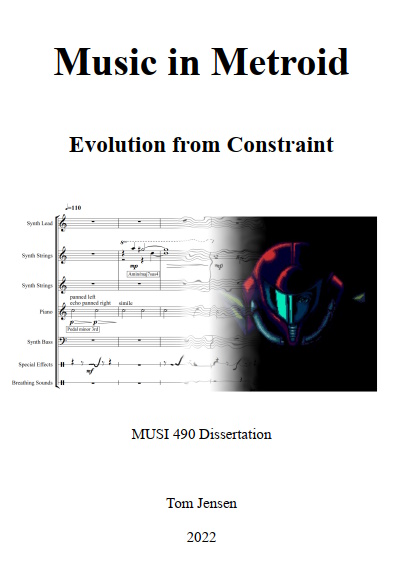
In early 2021 I saw a post on twitter about a game designer looking for a composer. The project looked very cool - a retro-feeling ~16-bit art style, with a plague doctor main character. It was a Roguelike, inspired by an obscure German roguelike from the 1990s (well, obscure outside of Germany), called Die Gemäuer von Kalawaum.

I Love Roguelikes, so it was a excited to see if I could get involved. I used to play a bit of NetHack, ADOM, and an incredible roguelike called Infra Arcana.
For those of you unfamiliar with the Roguelike genre, they are generally top down, randomly generated dungeons (sometimes entire worlds) that you explore and try to progress through. They get harder and harder as you descend through the levels, and if you die - that's it, you gotta start all over with a new character. Being a roleplaying gamer from way back (mostly D&D and Traveller), I had always liked this deadly lack of save games.

Rogue - the very first "Roguelike". In the old days they used ascii characters instead of graphics... You play as the "@" sign
The images of this Calaworm game looked fantastic - it was an interesting combination of a dark ages, cthulu-inspired setting, presented in this retro pixelated style - a combination that would in the end take me a long time to work out how to represent musically.
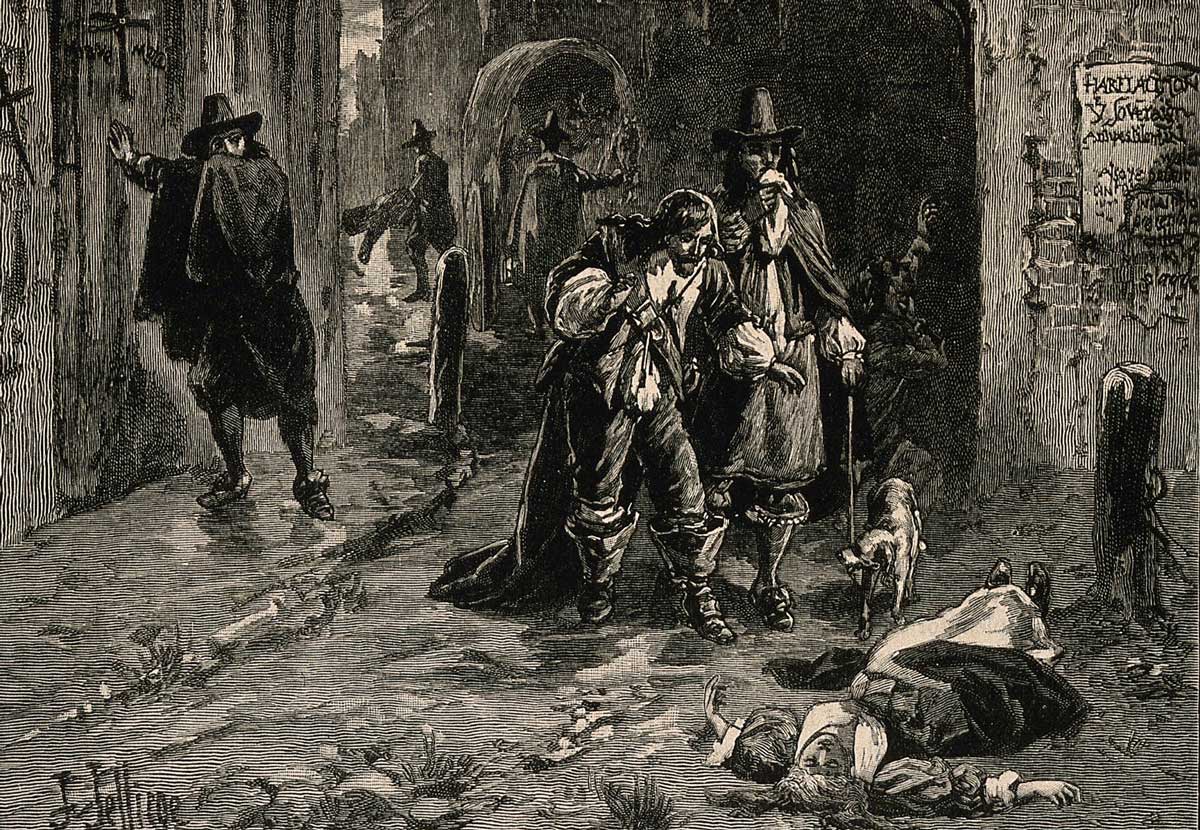
And so I presented the game dev with a sample of my work, showing him my "Firebeak" retro action music pack. He checked it out, but in the end it was my Gothic Horror music pack that really caught his attention, as the game contained lovecraftian horror elements and the developer was looking for more of a modern sounding score than something in the 16-bit or MIDI style.
The game was set in the Dark Ages, with the player being a plague doctor sent to investigate a strange castle. While the original setting is dark ages, elements of fantasy, Lovecraftian horror and steam-punk science-fiction also permeate the setting, making it an interesting mix of genres, especially once we factor in the slightly comical presentation and some of the tongue-in-cheek dialogue...
I initially tried to write some quite dark music for it, drawing mostly from the dark setting and the look of the screenshots I had seen. Going with my instincts, I wrote this - using a super nintendo organ sample, and some very heavy, reverb drenched percussion.
My first sketch for the developer
This direction, while it suited the dark setting, was a bit too serious for Alexander (the game developer), and looking back I definitely went for more of an atmospheric horror vibe.
So I had to find a middleground, something that reflected the more whimsical aspect of the game's visual aesthetic, and some of the not-too-serious antics that occur (at one point a cultist accidentally jumps down a hole, complete with cartoonish whistling sound effect).
And so I came up with this - a kind of duet for NES synth and viola, with renaissance recorder and flute helping to add some texture.
A more whimsical sketch - a duet between NES synth and viola
This was still a very early sketch, but I like to try to do a lot of sketches in the early stages of a project to make sure I'm going in the right direction. I sent this track through to Alexander, and he was happy with the direction, so I continued, adding atmospheric sounds, other sections and polishing up the track.
Here's the final track:
This combination of retro synths and real instruments seemed to be a great fit for the game, and through this process we also came up with some key words to describe the game - "Creepy Cute" or "Cute Horror". Key words are incredibly useful for composers and artists to understand the intended direction for a game - I like to ask a developer "how would you sum up the game in 2 or 3 words"?
So with a solid direction for moving forward, I decided to do some research and try some other angles, to see if we could build up a lexicon of sounds and styles to draw from. I looked into real dark ages instruments, and put together a track using some folk music percussion, and a weird old reed instrument called a "Crumhorn", which sounds like this:
Alexander very politely said that he preferred the more playful style of the earlier sketches, and essential not to try any of that Medieval stuff again...
And so that was progress - I knew what not to do, and I knew what kind of style he liked, but I still wanted to try to find other elements to create more of a language for the score than just "NES synths and acoustic instruments"
I had always loved the work of the 1980s / 1990s era composer Alfred Schnittke, whose music was often banned in Russia where he lived, and who wrote in a style called "polystylism", where he would draw from, mix and quote many different genres. There might be atonal bells one second, then Balkan brass band, then a few bars of a Tchaikovsky piano concerto out of nowhere... Needless to say, he was a pretty cool guy and although a lot of his music can be very bleak, he has also written some very humorous and unusual things.

One of my favorite photos of Alfred Schnittke
One particular Schnittke piece is called the "Gogol Suite", which was originally the music for a play based on the works of Russian proto-surrealist writer Nikolai Gogol
I first encountered this piece through a youtube video with an orchestra doing shots of vodka while playing the music... (note you might want to turn the volume up for this)
This piece had it all: tongue-in-cheek seriousness, complete idiocy, weird cartoonish sound effects (look up an instrument called a "Flexatone"...), harpsichord, electric guitar and bass guitar, little bells, weird waltzes... I thought it would be perfect for a creepy cute style inspiration. I sent the entire piece to the dev Alexander, and asked him to have a listen and note down any parts that could be useful for the game.
This piece ended up being an awesome touchstone for the Ruins of Calaworm score: providing humor, instrumentation ideas, and just generally being a cool thing to draw from. One of the first "Schnittke Inspired" pieces written for the score was this, the "Eldritch Investigation" (Alexander came up with all the names for these, which was really cool - not often the gamedev gives your pieces titles!):
This track started to forge the soundscape of Calaworm - strange combinations of instruments like Bassoon, prepared piano (when you stick all sorts of weird screws and pieces of wood into a piano), harpsichord, drumkit, trumpet, and of course the NES synths. Oom-pah and waltz rhythms, lyrical solos, adding in random extra beats for comic effect, weird sounds, carnival-like synths, my own voice, Spanish-style trumpet solos...
There was a humor and light-heartedness to the music, somewhere between deadly serious minor harpsichord chords, and the Milhaud-inspired close woodwind harmonies. Hell, I even snuck a medieval crumhorn in there...
Le Boef Sul Le Troit - another inspiration for this kind of "Surrealist" style - Darius Milhaud is a really cool composer, and this piece features lots of interesting stuff, like woodwind in very close harmonies (like 1 semitone apart the whole time...)
While the first few areas of Ruins Calaworm worked nicely with our newfound creepy-cute style, the deeper you go into the depths of Calaworm, the darker and more terrifying things become, as the true lovecraftian horrors start to emerge.
So clearly we needed some more ambient, unnerving tracks... I was able to return to some of the ideas in my original sketch, haunting synths, percussion drenched in reverb, strange sounds, and suchlike, and wrote two more tracks. One for a medium-level "it's getting spooky" and one for the ultimate "we're literally all going to die down here" type levels.
The medium level - "shit's getting spooky" track:
This track made use of NES synths with a ton of reverb, playing pseudo-atonal arpeggios. Tin whistle played by myself with strange bends, staccato cello, and cor anglais (it's like a larger, deeper oboe) helped to add to the strange atmosphere. Organic recorded sounds provided a more organic background texture, and the track eventually culminates in an almost baroque-style section, with synth and cor anglais solos...
The "We're doing to die down here" track:
One inspiration for this track was a requiem by a composer called Ligeti -it was a 20th century choir piece, with very dissonant harmonies:
Ligeti is a very cool composer, and well worth checking out, especially "Le Grand Macabre" - an "anti-anti-opera", which picks up the story of someone dying after choking on a hamburger... (not really, but the production linked starts that way)
If you only ever watch one opera, I'd say check this one out - it's about as far from regular opera as one could imagine.
So, we had cute-horror music, and deep deadly ambient tracks, but we still had a few more elements of the game that needed musical accompaniment.
Alexander had a final battle planned for Calaworm, and needed some energetic boss music... Once again coming back to Schnittke's Gogol Suite, I decided it would be cool to channel the energy of the opening movement, which you can hear below:
It's one hell of a piece if you want to listen to the whole thing...
So I went about taking that initial energy and re-creating it in my own way - bold, brazen chords, punctuated by silence (and in my case with timpani hits as well, instead of the comical sound of the flexatone as in the Schnittke), then dissolving into a driving oom-pah rhythm. I used the full arsenal of instruments I had built up for the Calaworm score: NES synths, Bassoon, harpsichord, bass guitar, drumkit, synthesized percussion, trumpets, and a few other brass like trombones to fill out some of the chords. Even some new instruments appeared - flute, especially played "Flutter Tongue", which creates an interesting fluttering effect.
I had a lot of fun keeping the energy up and programming all sorts of crazy drum solos...
Well, that's the bulk of the Calaworm soundtrack, there are quite a few other tracks in the game, but I won't spoil any of them, and let you experience them yourself instead!
You can check out the latest version of The Ruins of Calaworm here:
Hope this has been an interesting and enlightening journey, I will leave you with this cryptic picture:

Schnittke's Grave - the musical notation means "Silence, held for a long time, and played at the loudest possible volume"


REKKR - the viking / norse total conversion for the original Doom was doing pretty damn well by this point - it had been released by Bethesda through their mod workshop, and we had all been given a cash bonus from the company who we had only dreamed of working with as kids (iD software). It was at this time that project lead Revae was looking at creating a proper 4th episode for REKKR, as the 4th episode in late 2020 was a collection of maps that didn't make the cut for the original 3 episodes. Revae and his mapping minions were on the job, however, and had come up with an entire fourth episode of new maps.
Revae had also been tinkering with an executable for REKKR (rather than running the .wad file with something like zdoom) and gearing up for a full steam release. While he didn't have the budget for a full musical score for this new 4th episode (named "Sunken Land"), he did commission me to write three new tracks for the episode. These would be for the maps E4M1 - Postern, E4M7 - Ill Ellii, and E4M8 - Gardien.
The music for E4M1 was fairly straight forward, and the music for E4M8 was to be boss battle music, but the map E4M7 / Ill Ellii posed a bit of a problem: the map involved time travel to 4 quite disparate locations. Firstly the player was taken to Ancient Egypt, and later in the map would visit a science fiction moonbase, modern day city, and ancient Rome... So how would I handle writing music for this? Clearly I need to find a middle ground that would support all 4 areas without leaning too much into the setting of either.
I decided to try find a cool angle that fit the idea of time travel. Some people (ok mostly just Goethe) say "music is liquid architecture, architecture is frozen music" - so music already exists over a period of time, I can't just write music and say it makes use of time, but there is a way to tinker with time using music...
I decided to make use of a musical device that involved temporal shenanigans - something as old as time itself (well as old as the baroque period at least) - the canon cancrizans, or "Crab Canon".

Many moons ago (ok 1736), composers liked to play little musical games and puzzles, like "what If I played this piece upside down", or "what if we put this piece of music between us and played it reading from different directions?". Pieces like Bach's "The musical Offering" are full of these, and sometimes they'd expect the 'reader' to complete the puzzle in order to play the piece.
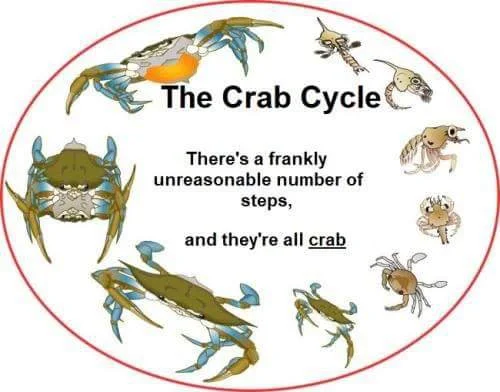
So what's with the crabs? well, one of these musical puzzles was called a Crab Canon, which involved a melody that if played backwards, would accompany itself. So how does this work? well, counterpoint - counterpoint.
counterpoint is like, I have a melody, and now I want a second melody that sounds good when I play both melodies at the same time. If you do it right, it sounds great. If you do it badly, it sounds meh. Composers in ye olde days loved counterpoint, but nowadays people think it's a bit old fashioned. To be fair, most composers don't think it's old fashioned, and in fact use it all the time, just maybe not as extensively as they did back in the period from like 1500 - 1900
Anyway, history lesson aside, crab canons are cool, and you can do cool shit with them.
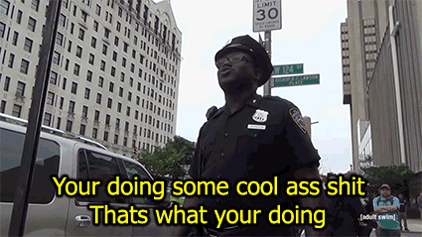
So I set out to write a crab canon, and use it as the spine of my track for this time travel map. Thanks to a little video from Adam Neely, I had some good resources on actually approaching the writing of a crab canon, as it's not something you can just kinda dive into.
And here's what I ended up coming up with - note this is MIDI data rendered by a default windows synthesizer, it aint gonna be pretty:


Note the backwards looking treble clef on the right hand side of the image above? yeah that's the secret code old timey composers used to say "play this fucker backwards and see what happens my dude"
The final track opens with a blown bottle motif, and immediately launches into heavy drums and low synth pads. Solo harmonica – an instrument I began to associate with loss of sanity – enters the fray, often microtonally pitched to unnerve the listener. The whole track has an eerie feeling, which is emphasized by the slow crab canon starting at 0:35. Material in this section seems to move forwards and backwards, appearing from different directions, and sometimes moving in opposite directions at the same time. By 2:06 the crab canon concludes and a more direct action section takes place, intensifying into a harmonica solo at the end of the track:
To be fair, a crab canon is something that no one would even notice just by listening - its more of a fun personal joke for the composer. It just so happened that in this case the unnerving, odd feel of the crab canon suited the gameplay and setting-jumping of the map nicely.
An example of one of Bach's more famous crab canons:
For the very last map of the game, involving a fight against the game's main antagonist, I had to write some BOSS MUSIC! The first draft for this track was quite high-energy:
Project lead Revae had the following feedback on this track:
“That might be a little too high energy for the parts where you're not fighting, after the boss. It sounds nice, but aggressive. Trying to think of a way to balance that. Like if it were more like a dance or something. Or sinister I guess. A sinister waltz”
So I started again, trying to hit the sinister waltz trope. I presented two options to the Revae, a slower and faster version. The faster version was chosen, and so I progressed and expanded on the track, keeping the fast 3/4 feel throughout.
The final track takes us through this sinister waltz, with plenty of bending oboe solos, heavy drums, organ, harpsichord and choirs:
And so that's the story of the final phase of REKKR - it was released on Steam on 21st October 2021, to glowing reviews:
Two years ago I was browsing a certain forum when I saw a screenshot of what would become REKKR. I immediately volunteered to write some music for the project, posted a MIDI file and emails were swapped. Now that REKKR has been released, I thought I'd write a little bit about my process for the soundtrack.
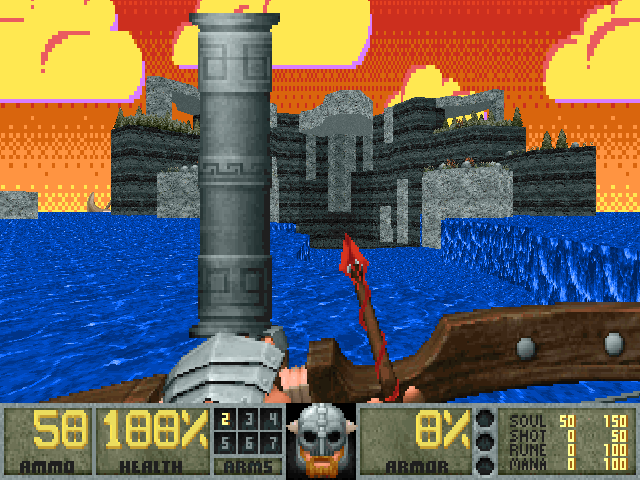
Going on the original screenshot, I figured REKKR was some kind of viking / fantasy style mod. It being a Vanilla TC, anything but MIDI was out of the question. I fired up my DAW and quickly selected some instruments I thought would be appropriate: Percussion, choir, strings, harp/lyre and bagpipes. I went with my gut instinct and wrote this:
The project lead Revae seemed happy with the direction I was going in so I wrote a few more gut-instinct tracks, trying out some more ideas and sounds. I ended up having free reign to write what I wanted in this score, except for some small timing things like getting the title track to end before demos start, so plenty of room to experiment.
Then I started thinking more critically about what I was doing - This was a Norse inspired setting, so I needed to research Norse instruments and tunings. I started looking for Scandinavian folk music and instruments, and came across some key pieces that would provide important elements of the score.
This video in particular had a striking effect on me:
What was this ethereal, natural sounding instrument? It was a Bukkehorn - a natural horn carved from the horn of a goat.
But there was something else going on in this piece, it wasn't just a beautiful sounding instrument, but the musical Scale was different to our regular western scales. This is due to the horn being made by drilling holes in it, often without too much precision (and certainly the natural shape of each horn would have an effect on the exact pitches it would produce).
And so I went about trying to recreate not only this sound, but the kind of natural scales that we hear in the piece above. I would make these scales using Microtones - a way of retuning notes so they sit in between the usual notes that we might play on a piano. I wouldn't retune all the notes, but just a few of them in a given scale. I would retune them enough to give the melodies a unique and unusual sound.
Listening to some more of these pieces, some were very 'sour' sounding - the pitches well outside our usual piano keyboard. This one for example:
You can hear some of the notes just sound 'off'. This was the kind of sound I wanted to make use of. It sounded ancient, perfectly natural, yet aeons away from our modern music.
Other Scandinavian folk music such as dances and instruments like the Tagelharpa were also noted and their styles put in the 'bank' of things I would make use of in this score. Tagelharpa:
So I set about attempting to recreate these ancient Scandinavian sounds in my DAW. I even began naming the instruments after the ye olde ones.
I used solo violins or violas for Tagelharpa, and a soprano saxophone seemed to work well for a Bukkehorn (I'm still limited to MIDI sounds here - no going out at getting a high quality Bukkehorn library.... assuming one existed?)
I wrote this, my spin on a Bukkehorn melody:
And this, my take on a tagelharpa piece, with drone and folk percussion and in with a folk dance feel:
You can hear I'm trying to accentuate the roughness of real played instruments - there are bends in the strings as a player bends up to the note, also featuring are the microtonal scales I devised in order to give the melodies an ancient, natural sound.
The scale I used for the Bukkehorn piece (Hops Harvest) was as follows:
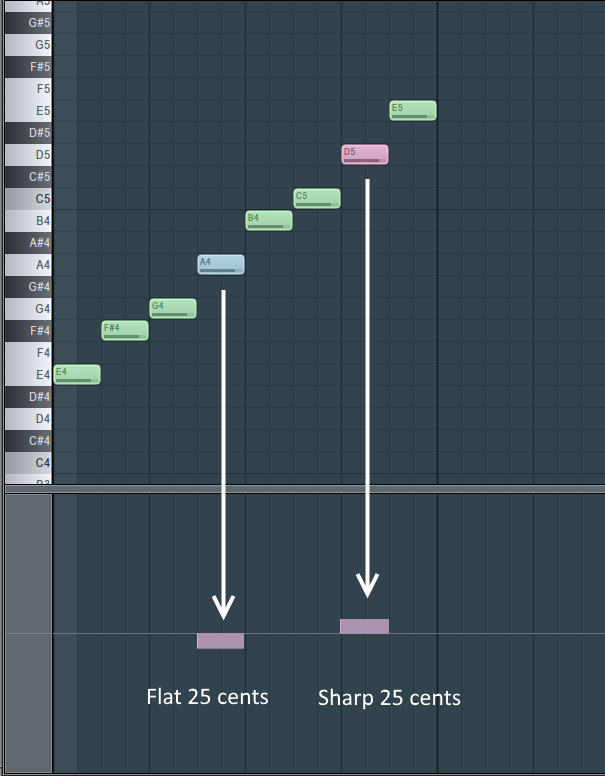
A relatively straight forward E aeolian mode (also known as E natural minor), but with 2 notes altered. One altered downwards (flattening) by an amount of 25 cents. Cents you say? how many cents to a dollar? One of my first teachers asked me this at primary school and I replied: "How many *what* cents?" How many 10 cents? how many 20 cents? I couldn't understand that she meant "100 cents in total". I was thinking in blocks of 5, 10 or 20, rather than imagining a dollar being made up of 100 individual cents (I was like 6, give me a break).
How does this relate to altering notes and micorotonal tunings? well - in the same way I was thinking about cents in blocks, most people today think about musical notes in blocks too - the keys on a piano. Thats all the notes there are right? wrong. The distance between any 2 notes on a modern piano is measured as "100 cents". I don't know where the name 'cents' comes from, but that's just what they're called so we're going to run with it.
You could have 100 different notes between any 2 notes on a piano. They would be incredibly close together, and most people would not be able to tell them apart unless you played them all in sequence (you would hear a weirdly rising scale than never seems to actually get higher)
You can kind of hear this effect in this video:
That video is in quartertones - so 50 cents between each note. (lets not get into why they're called quartertones...)
Anyway, back to my scale

I altered 2 notes, one downwards by 25 cents, and one upwards by 25 cents. This is enough of a change that the human ear can easily recognize that something aint right, but small enough (only 2 notes out of a 7 note scale), that I could still write regular melodies and have the tunes work and for the regular western person to be able to relate to them. Some areas such as India and the middle east use much smaller intervals (the distance between 2 notes), and so could easily write in much more complicated microtonal scales and even sing them, but for me the 25 cent alterations were enough to give the music an ancient feeling.
This effect seemed to work most of the time when I used it in the score, the melodies sound relatively normal, but sometimes the effect is quite pronounced, which could well be a shock to some western listeners (a recent twitch playthrough of REKKR commented that this track was "awful" and laughed at how bad it was.) This was the 'sour' microtones hard at work, sounding like someone was torturing a cat 2000 years ago:
And looking back I think I did go a bit far on this track. I could have removed the alterations and the track would be much nicer to listen to. But hey - I think one nice thing about REKKR is it's uncompromising - the maps are hard, so imo the music should be hard to listen to at times. Only the first section of this track uses the microtonal scale, the rest is relatively straight forward (so I give the listener a 'rest' from the sour notes...)
More Microtonal scales:
So that covers the main unusual aspects of the project - researching and utilizing natural scales and instrument types. But REKKR isn't all Norse strongmen living in huts - there is much more to the setting. As I started seeing some of the city maps come around, I figured it was time to introduce a more refined, ""cultured"" element to the music. So I drew on my favorite musical inspiration: Baroque and Renaissance period classical music. I introduced the Organ, more structured polyphony (many melodies interweaving), and more refined harp parts.
I spent quite a few tracks trying to really nail the most "crunchy" organ sound possible - I wanted really dense chords and clear but overwhelming harmonies.
I think I finally nailed it in this track, which I believe was unused until I mentioned that it was, and it then became the intermission track (a great choice by Revae):
Inspiration came from sources other than just Scandinavian folk music and baroque fugues and counterpoint, traditional songs - especially vocal-only songs (known as acapella) were a good source of the kind of music that could be made even without any instruments - perhaps by a bunch of viking woman on a boat, or some Russian girls on a train, as shown in this song:
The track above and vocal songs like it provided the inspiration for some of my own:
As an aside, if you want a few really great female vocal pieces, look no further: These 2 tracks also feature quite microtonal vocal parts - making them sound partially middle eastern or indian.
The human voice is truly something powerful.
As the mod went on, more styles and variety were required, I wrote a more standard metal / rock track for a dungeon map, and even managed to sneak in some Black Metal for the claustrophobia map in the 3rd episode. There were synths used, especially in the first map of E3, coinciding with the change of scene in the 3rd episode (bright purple + smooth futuristic looking walls). Some other styles and genres cropped up, a swamp map, a map for a city (heavily inspired by Edgar & Sabin's Theme from FF VI), boss music, episode end screen music, and a final "credits music" (taking the shape of a bittersweet waltz), and HELL maps. I had a great time writing in this variety of styles, while trying to keep a rough harmonic language consistent throughout. I've loved working with MIDI since I was a teenager, so its always fun to work within those limitations.
More metal dungeon track:
Regal city music:
Then a request came through that made me go ooooooooo: (slight spoilers ahead)
A mash up of all the starting areas of doom, doom2, hexen, heretic, strife and a few others. It was a secret map, and I got straight to work. I took the 1st map music from all these games, and re-envisioned them using my REKKR instruments and sensibilities, harps replaced electric guitar in the Heretic E1M1 music, bagpipe solos ripped over the Strife polyrhythms, and things just kinda came together. Combined with the visuals of that map, and all the familiar areas, I hope it makes for a fun easter egg.
I used a few small things to help make the MIDI a bit more lively, namely layering solo instruments with a very slight staggering in the parts, to make it sound like they were playing in a reverberating hall. So I would have 3 bagpipes all playing the same notes, but one slightly after the other, and the other slightly after that.
There are also plenty of seashore sounds used, lots of pitch bending, and very careful attention to volumes and fading in / out. Sometimes I would put so much automation (programming how the volume / pitch / etc. will change over time) that the file sizes bloated above 100kb (preventing them from playing in chocolate doom), so I had to go back and 'simplify' automation, which had very little effect on the quality of the sound. The difference between a volume curve with 500 points and a volume curve with 10 points is minimal when you have other instruments playing. This was purely something I've been used to from writing non-doom music: being able to draw smooth curves and never have to answer for those extra kb.
And so that's the story of the music of REKKR, I haven't uploaded all of the tracks to my youtube yet, I will do a bit of a rearrange now that I know what has been used and what hasn't, and include some of the more recent tracks (such as the metal tracks, the swamp track, end titles and a few others).
For now I will leave you with the end game title music (the bittersweet waltz). This track pushed my available voices to the absolute limit:
So that's the story of the music of REKKR - I hope this has been of interest!